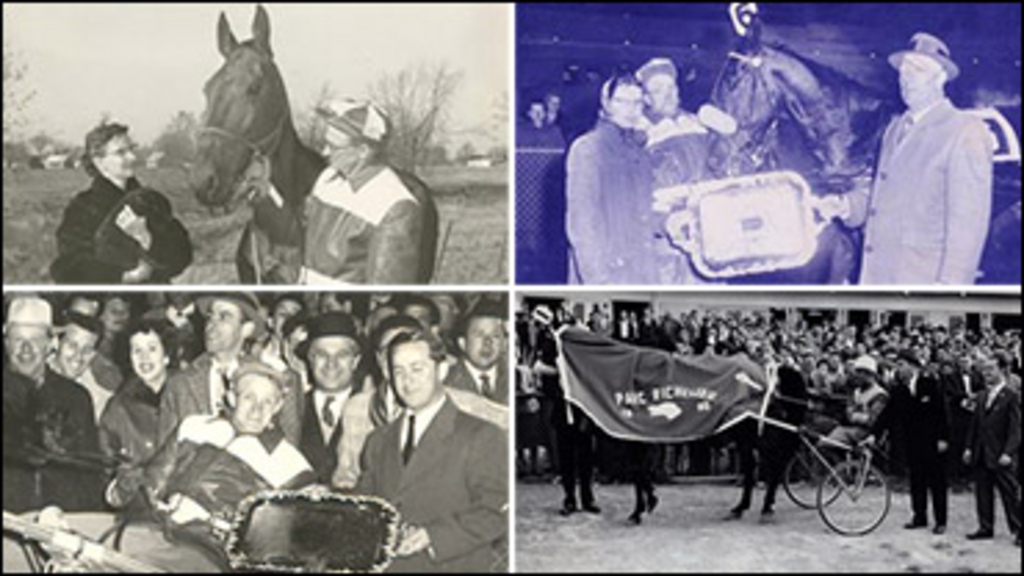
In this week's 'Rewind,' Robert Smith turns the calendar back to 1958 and recalls some interesting happenings involved with the once popular five-mile races or as the locals called them, Le Cinq Milles. His story traces some of the history behind a very accomplished five mile performer from that long ago era. His story even includes some very recent quotes from the horse's owner despite the passage of 60 years.

A very proud Jim Wallace of Dauphin, Manitoba appears with his great five-mile trotter Grattan Baker. This horse was highly successful in longer distance races during the years surrounding 1960. (Wallace family collection)
Sixty years ago, right about now on the calendar, a virtually unknown horseman from Western Canada and an equally unknown horse were making the headlines in Canadian harness racing. Jimmy Wallace from Kenton, Manitoba and his "wonder" horse Grattan Baker were thrilling the huge Montreal crowds on Sunday afternoons. By now most of the important happenings for the 1958 season were already in the record books but the one main title was still at stake. For many years the Quebec racing circuit unofficially crowned a special horse at the end of the season and that individual had to be pretty special and also very durable. This horse had to win a five-mile race and in fact maybe several "five milers" in order to gain this special recognition.
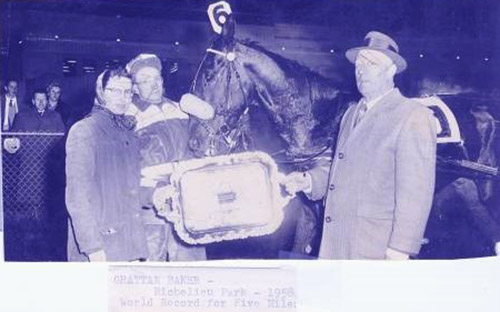
Five Mile World Record Holder (On The Trot) Grattan Baker shown with Betty and Jim Wallace in October 1958. Presenting the silver tray is C.R. Bradley at Richelieu Park. The five mile time was 11:52.1. (I think this may still be the record)
The horse Grattan Baker was known by a somewhat peculiar term as he was referred to in the Montreal press as a 'Natural Router'. This rather unusual title apparently refers to a horse's ability to perform well in a long distance race. Since most harness races are contested at one mile, this attribute was not often a factor. But there were exceptions.
Fans in attendance at Richelieu Park's Sunday, November 9, 1958 afternoon races were witness to a rather rare five-mile race, the second such race held there in two weeks as the season drew to an end. Despite the fact that Grattan Baker had won a similar event two weeks earlier on October 26th, he was still not installed as the betting favourite. That honour belonged to Bannock Bay, another horse adept at going the long distance. For several years these two aged geldings, one a pacer the other a trotter, duked it out for top billing whenever a five-mile race was held.
When Grattan Baker, affectionately known as "Jake", won this race on Oct. 26 he stunned the entire crowd as he took the lead at the three-mile station and held it to the finish. I believe this was his first ever start in a longer distance race. Let go at 29-1 odds, he paid $60.40 to those few who backed him instead of Bannock Bay. Four of the original starters failed to finish but one of them, a horse named Gratis, provided plenty of entertainment just the same. Driven by George Harp Jr., Gratis gave the huge crowd a few laughs and thrills when he broke three times but kept coming back to threaten the leaders. Finally however Harp gave up the chase and dropped out.

Grattan Baker and driver Jim Wallace at the rail holds the lead at the end of five miles as Coramine Volo (4) and Keith Waples almost catch the eventual winner
On this day (Nov. 9th) owner Jim Wallace of Dauphin, Manitoba took Grattan Baker to the front after the one-mile station and held the lead the rest of the way. Despite the long distance, the outcome was in doubt until the final strides. A fast-closing Coramine Volo driven by Keith Waples apparently had a bit left in the "tank" as they trotted toward the leader but came up a length short in second place. The third place finisher was Tyrone Hanover, also a trotter driven by Percy Robillard. The favoured Bannock Bay faltered a bit at the 4-1/2 mile mark and finished fourth for driver Laurent "Larry" Paiement who was just 19 years of age at the time.
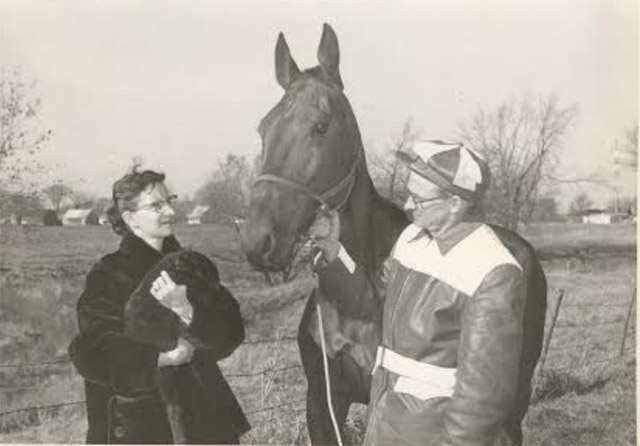
Betty and Jim Wallace of Dauphin, Manitoba appear with family favourite Grattan Baker, also known as Jake. (Wallace family collection)
This special five-mile race went as the afternoon's featured event listed as "Free For All Trot & Pace" and carried a purse of $2,500. A total of 12 horses faced the starter but only five reached the finish line. Time of the event on a cool day was 12:07.1 for the five miles. With the favourite out of the money, Grattan Baker paid a nice $17.00, $5.70, $ 4.30 across the board, not quite as lucrative for the betting public as his earlier win.
Three Five Milers in Two Weeks
In a span of just 14 days three such five-mile races were held at two Quebec tracks and many of the same horses were in each event. This meant that those horses who completed each race went a total of 15 miles under race conditions in two weeks! (it is doubtful that many training miles were required) The above mentioned two races at Richelieu Park saw Grattan Baker a winner each time. In between these two, on November 2nd, the race site moved some 150 miles eastward to Quebec City. On that day, a field of 14 faced the starter, with eight finishing and Bannock Bay gained the victory over Grattan Baker who finished second. This race carried a purse of $2,000 and was clocked in 11:37.1 which I think equates to an average mile time of about 2:20.
The winner of this best two out of three "marathon" was granted the status of "King Of The Five Milers" and the Provincial title for 1958. At this time the speed record belonged to a horse called U.N.O. who covered the five miles in 11:25 (on the pace) at Richelieu Park four years previous in 1954 for the stable of Theo Turcotte and driver Ron Turcotte. Ironically Bannock Bay was handled by this same Ron Turcotte earlier in the horse's career.
As the horses and horsemen headed for winter quarters they could begin to plan and think about the next year's big races. A number of horses in Quebec during this era were known for their peculiar ability to do well in five-mile races. They waited each year to "shine" when the occasion arose as they generally did not do all that well in one mile events.
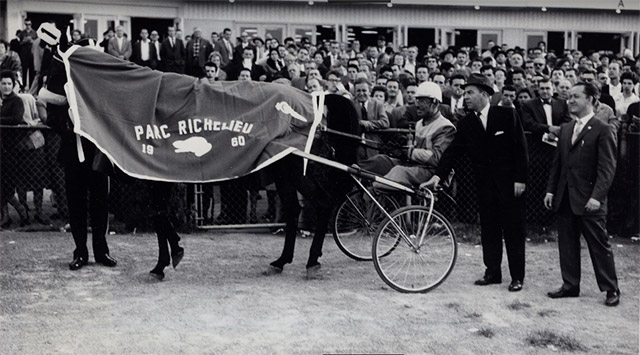
In 1960 Grattan Baker was still winning five-mile races. While the Wallaces were back home in Manitoba horseman friend Pem Caldwell continued to race the ten-year-old as he appears in the Richelieu Park winner's circle following a victory timed in 11:52.2. Presenting a cooler and a trophy on behalf of Richelieu was Georges Giguere
More About Grattan Baker
I am indebted to a lady named Betty Wallace for her assistance in putting this story together. How often in this day and age does anyone take the time to send three full pages of typed material? (yes typed, not done on a computer!) Well this lady did. She recalls all of the happenings just as they occurred 60 years ago.
Grattan Baker was an interesting study. He was not born into royalty nor did he fetch a high price in the auction ring. He began his life in almost total obscurity, perhaps not even intended to be a race horse but rather for use as a "road" horse. At this time fast stepping teams were still being used to travel over snow covered roads in rural Manitoba. Mrs. Wallace referred to one occasion when Mr. Jack Goodwin, the man who raised Grattan Baker and lived out in a very rural area, hitched a team in the dead of winter and drove into town which was some distance away because he was out of cigars!
Around 1954 Jim Wallace took possession of Grattan Baker following an offer to sell the then four-year-old gelding along with his harness for $100.00. The offer was accepted and the new owner set about training him on the trot. He had been tried as a pacer with disastrous results but apparently a new style of knee boot recommended by a local man named Lemay started the turn around. She recalled "it was a half boot that just buckled above the knee." It worked wonders and soon the converted pacer was on to bigger and better things.
In the next few years Grattan Baker made a name for himself and a lot of people got to also know the husband and wife team of Jim and Betty Wallace, who were newlyweds at the time. For a few years they travelled from Manitoba to Montreal to take advantage of the bigger purses. The long trek eastward was an interesting and rewarding experience.
Grattan Baker last raced in 1963. His effectiveness on the track had diminished to the point that it was time to call it quits. He went into retirement with a mile record time of 2:09 taken at age seven and earnings of $21,500; not too shabby for a 'road horse'. The Wallaces travelled to Quebec to pick him up and returned to Manitoba. On December 24th they loaded their young family in a cutter and outfitted their prized horse with several sets of sleigh bells and headed into the local town. Mrs. Wallace stated "Jake was doing what he loved to do and we stopped a lot of traffic that day."
Shortly after this time the Wallaces detected that their old war horse was not himself and not too long into his retirement years it was necessary to have him euthanized due to an incurable ailment that was causing him a lot of pain. While his statistics were certainly not spectacular the enjoyment he brought to his owners was beyond measure. Soon after his five-mile heroics in 1958, the silver tray received in Montreal was given to his original owner and breeder Mr. Jack Goodwin of Oak Lake, Manitoba. To this day, over 60 years later this horse and what he meant to an entire community is still a topic of conversation whenever those who remember him gather together.
While five-mile races were a once popular event on several Quebec tracks they eventually came under scrutiny from the humane society or some such group and were banned. Mrs. Wallace said "We heard of horses that supposedly died after five-mile races but we never did hear the real answer why they were stopped." She theorized that it was as a result of trainers who didn't know how to convert a horse from a mile to a distance horse.
"It takes a good old prairie-bred horse or one that comes up from the Ottawa Valley; one that listens to his driver and has the guts and heart to go the distance." My thanks to Mrs. Wallace for her interesting comments.
Five Mile races continue on today as part of the Quebec regional fair circuit.
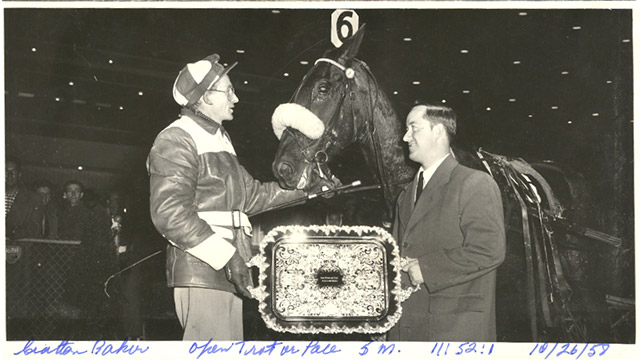
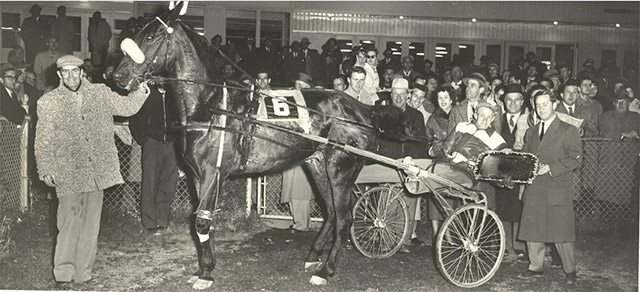
Oct. 26, 1958 - Jim Wallace of Kenton, Manitoba receives trophy from John Beauchemin after Grattan Baker won the annual five-mile race at Richelieu. A Canadian racing tradition - the five-mile race - was upheld at the Richelieu meeting recently when Jim Wallace's Grattan Baker covered the extended route in 11:52.1. Winner of only $570 thus far this season, the nine-year-old gelding had to turn back a field of 12 in the $2,000 test. His closest rival was Bannock Bay, the even money favourite and winner of three "five-milers" earlier this fall, two at Quebec and one at Three Rivers. (Quote and photo from Harness Horse)
Where Is It?
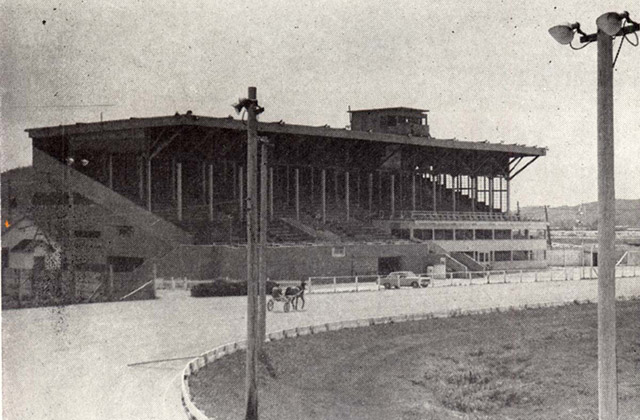
Can you identify the location of this old track? (Hoof Beats photo)
Stay tuned for the correct answer this coming week.


This week's picture was
This week's picture was correctly identified by a couple of gentlemen as being the grandstand located at Exhibition Park in Saint John, N.B. These old, mainly wooden structures are rare symbols of a bygone era. Unfortunately most if not all of them have disappeared but the old pictures help to revive their memory.
The following is an excerpt
The following is an excerpt from a 'Rewind' published way back on February 27, 2010. It seems to be relevant to today's story.
"Legendary Londoner Barney Hughes was racing his stable in Montreal. He had one horse that was believed to be a "sure thing" if ever entered in a five-mile race even though she had never previously competed at that distance. When the race secretary carded such an event he was quite surprised that Barney did not drop his entry in the box so he called him into his office. Why didn't you enter your horse... you're leaving town? "No" Afraid of getting beat? "No" Don't think she can go enough? "No" Well what is the problem? Barney's reply: "To be quite honest I don't know if I can go that long without taking a drink!"
Thanks Robert for the very
Thanks Robert for the very interesting article! I think they were stopped because most drivers could not stay focused that long, or could not count that high to remember what lap they were on.
Exhibition Park Raceway in
Exhibition Park Raceway in Saint John, NB?
Exhibition Park Raceway,
Exhibition Park Raceway, Saint John New Brunswick